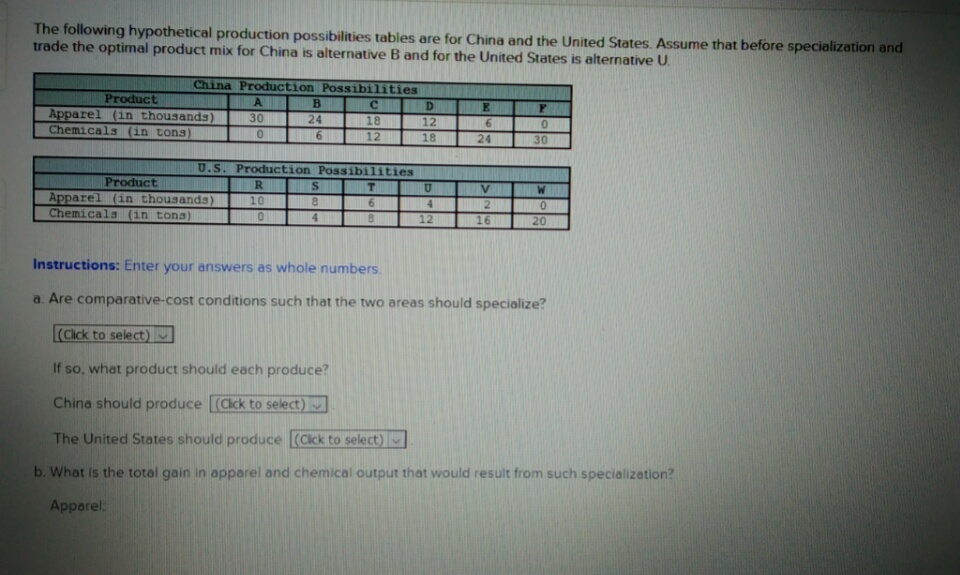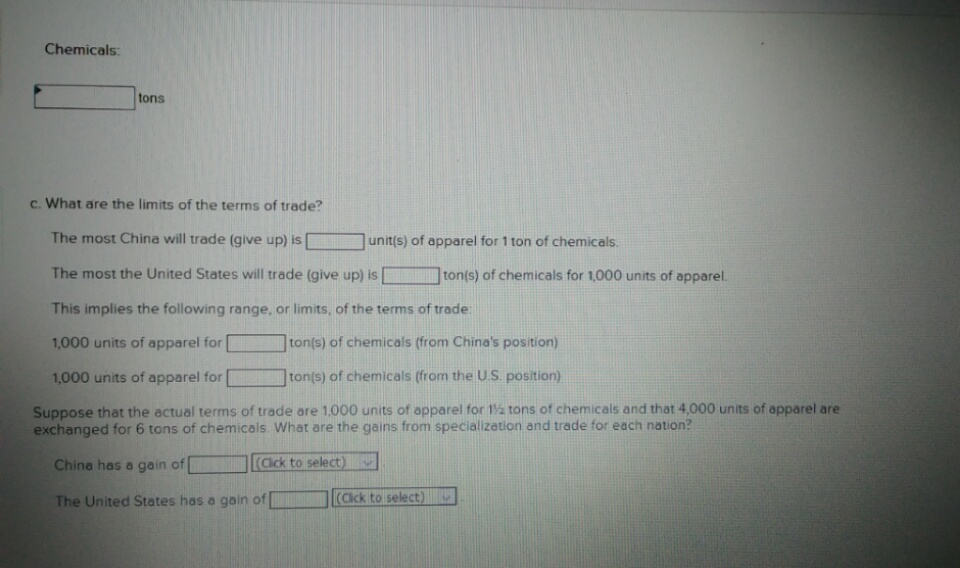The following hypothetical production possibilities tables are for China and the United States. Assume that before specialization and trade the optimal product mix for China is alternative B and for the United States is alternative U. China Production Possibilities в Product Apparel (in thousands) Chemicals (in tons 30 24 18 12 12 18 24 30 U.S. Production Possibilities Product R T. Apparel (in thousands) Chemicals (in tona) 10 2. 16 4. 8. 12 20 Instructions: Enter your answers as whole numbers. a. Are comparative-cost conditions such that the two areas should specialize? [(Click to select) If so, what product should each produce? China should produce [(Cick to select) The United States should produce (Cick to select) b. What is the total gain in apparel and chemical output that would result from such specialization? Apparel: Chemicals: tons c. What are the limits of the terms of trade? The most China will trade (give up) is unit(s) of apparel for 1 ton of chemicals. The most the United States will trade (give up) is ton(s) of chemicals for 1,000 units of apparel. This implies the following range, or limits, of the terms of trade: 1,000 units of apparel for ton(s) of chemicals (from China's position) ton(s) of chemicals (from the U.S. position) 1,000 units of apparel for Suppose that the actual terms of trade are 1,000 units of apparel for 12 tons of chemicals and that 4,000 units of apparel are exchanged for 6 tons of chemicals. What are the gains from specialization and trade for each nation? (Cick to select) China has a gain of (Cick to select) v The United States has a gain of
The following hypothetical production possibilities tables are for China and the United States. Assume that before specialization and trade the optimal product mix for China is alternative B and for the United States is alternative U. China Production Possibilities в Product Apparel (in thousands) Chemicals (in tons 30 24 18 12 12 18 24 30 U.S. Production Possibilities Product R T. Apparel (in thousands) Chemicals (in tona) 10 2. 16 4. 8. 12 20 Instructions: Enter your answers as whole numbers. a. Are comparative-cost conditions such that the two areas should specialize? [(Click to select) If so, what product should each produce? China should produce [(Cick to select) The United States should produce (Cick to select) b. What is the total gain in apparel and chemical output that would result from such specialization? Apparel: Chemicals: tons c. What are the limits of the terms of trade? The most China will trade (give up) is unit(s) of apparel for 1 ton of chemicals. The most the United States will trade (give up) is ton(s) of chemicals for 1,000 units of apparel. This implies the following range, or limits, of the terms of trade: 1,000 units of apparel for ton(s) of chemicals (from China's position) ton(s) of chemicals (from the U.S. position) 1,000 units of apparel for Suppose that the actual terms of trade are 1,000 units of apparel for 12 tons of chemicals and that 4,000 units of apparel are exchanged for 6 tons of chemicals. What are the gains from specialization and trade for each nation? (Cick to select) China has a gain of (Cick to select) v The United States has a gain of
Brief Principles of Macroeconomics (MindTap Course List)
8th Edition
ISBN:9781337091985
Author:N. Gregory Mankiw
Publisher:N. Gregory Mankiw
Chapter3: Interdependence And The Gains Rrom Trade
Section: Chapter Questions
Problem 2PA
Related questions
Question

Transcribed Image Text:The following hypothetical production possibilities tables are for China and the United States. Assume that before specialization and
trade the optimal product mix for China is alternative B and for the United States is alternative U.
China Production Possibilities
в
Product
Apparel (in thousands)
Chemicals (in tons
30
24
18
12
12
18
24
30
U.S. Production Possibilities
Product
R
T.
Apparel (in thousands)
Chemicals (in tona)
10
2.
16
4.
8.
12
20
Instructions: Enter your answers as whole numbers.
a. Are comparative-cost conditions such that the two areas should specialize?
[(Click to select)
If so, what product should each produce?
China should produce [(Cick to select)
The United States should produce
(Cick to select)
b. What is the total gain in apparel and chemical output that would result from such specialization?
Apparel:

Transcribed Image Text:Chemicals:
tons
c. What are the limits of the terms of trade?
The most China will trade (give up) is
unit(s) of apparel for 1 ton of chemicals.
The most the United States will trade (give up) is
ton(s) of chemicals for 1,000 units of apparel.
This implies the following range, or limits, of the terms of trade:
1,000 units of apparel for
ton(s) of chemicals (from China's position)
ton(s) of chemicals (from the U.S. position)
1,000 units of apparel for
Suppose that the actual terms of trade are 1,000 units of apparel for 12 tons of chemicals and that 4,000 units of apparel are
exchanged for 6 tons of chemicals. What are the gains from specialization and trade for each nation?
(Cick to select)
China has a gain of
(Cick to select)
v
The United States has a gain of
Expert Solution
This question has been solved!
Explore an expertly crafted, step-by-step solution for a thorough understanding of key concepts.
This is a popular solution!
Trending now
This is a popular solution!
Step by step
Solved in 6 steps with 2 images

Recommended textbooks for you

Brief Principles of Macroeconomics (MindTap Cours…
Economics
ISBN:
9781337091985
Author:
N. Gregory Mankiw
Publisher:
Cengage Learning

Essentials of Economics (MindTap Course List)
Economics
ISBN:
9781337091992
Author:
N. Gregory Mankiw
Publisher:
Cengage Learning

Principles of Economics 2e
Economics
ISBN:
9781947172364
Author:
Steven A. Greenlaw; David Shapiro
Publisher:
OpenStax

Brief Principles of Macroeconomics (MindTap Cours…
Economics
ISBN:
9781337091985
Author:
N. Gregory Mankiw
Publisher:
Cengage Learning

Essentials of Economics (MindTap Course List)
Economics
ISBN:
9781337091992
Author:
N. Gregory Mankiw
Publisher:
Cengage Learning

Principles of Economics 2e
Economics
ISBN:
9781947172364
Author:
Steven A. Greenlaw; David Shapiro
Publisher:
OpenStax


